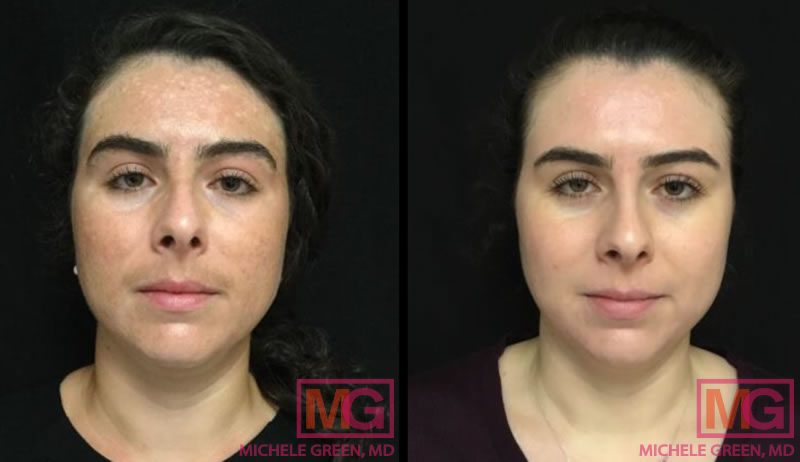Melasma & Hyperpigmentation
Hyperpigmentation is a broad term that describes spots or patches of skin darker than one’s natural skin tone. Various types of hyperpigmentation can develop, including sun spots, melasma, and post-inflammatory hyperpigmentation. Melasma is a chronic skin condition marked by dark brown or gray patches of discoloration. Proper diagnosis of melasma is crucial, as it cannot be treated with lasers designed for other forms of hyperpigmentation. While both melasma and hyperpigmentation are benign, their appearance can lead to feelings of self-consciousness and create a prematurely aged look. Fortunately, expert board-certified dermatologist Dr. Michele Green in New York City has been treating melasma and hyperpigmentation for over 25 years and will work with you to help you achieve and maintain a clear, radiant complexion.
Melasma and hyperpigmentation can be treated with various non-invasive cosmetic procedures. The most suitable treatment options for your skin condition will ultimately depend on your skin type, tone, and the severity and type of hyperpigmentation you have. Although they appear similar, melasma and hyperpigmentation are distinct skin conditions that require different interventions for safe and effective resolution. While sunspots and brown spots can be treated with specific lasers, melasma should only be addressed with chemical peels or microneedling to avoid worsening its appearance. The most effective approach for treating melasma and hyperpigmentation is a combination of in-office procedures and specially formulated skincare products to eliminate pigmentation from the skin and prevent its recurrence. When you consult with Dr. Green, she will create a customized treatment plan that leaves you with bright, even-toned skin that lasts.
Dr. Michele Green is an expert in treating sunspots, melasma, discoloration, and other hyperpigmentation disorders at her private office on the Upper East Side of NYC. A board-certified dermatologist with over 25 years of experience, Dr. Green is uniquely skilled in removing sunspots and facial hyperpigmentation while remaining at the forefront of safe and effective treatments. Castle Connolly, New York Magazine, Super Doctors, and The New York Times consistently recognize Dr. Green as one of NYC’s top dermatologists due to her dedication to patients and her expertise. Dr. Green employs a holistic approach and adheres to a less-is-more philosophy regarding facial rejuvenation. She will help you achieve and maintain even, beautiful, clear skin by developing a customized treatment plan that includes the best options, skincare, and broad-spectrum sunscreen.
What is hyperpigmentation?
Hyperpigmentation is a broad term that refers to any discoloration of the skin darker than the original color. It develops due to increased melanin production in melanocytes, the skin cells responsible for producing melanin. The primary cause of hyperpigmentation is excessive sun exposure. Harmful UV rays from the sun can trigger melanin production, leading to discoloration and dark spots or patches on the skin. Genetics can also contribute to hyperpigmentation, as some individuals may have a higher number of melanocytes or a genetic predisposition to produce excess melanin. Certain medications, including oral antibiotics and specific antipsychotics, can increase the skin’s sensitivity to sunlight and result in hyperpigmentation. This condition can affect individuals of any age, skin tone, and type. Although hyperpigmentation is harmless, many patients seek treatment for cosmetic reasons.
What are the different types of hyperpigmentation?
Common forms of hyperpigmentation on the skin include sunspots, freckles, post-inflammatory hyperpigmentation, and melasma. Sunspots, also known as age spots, liver spots, and solar lentigines, are flat brown marks that vary in size and shape, appearing on sun-exposed areas such as the face, shoulders, arms, and hands. Freckles are small brown spots that commonly appear in regions frequently exposed to the sun, such as the face. UV radiation from the sun stimulates the skin to produce melanin as a protective response, resulting in small, flat brown spots. One type of freckle, ephelides, is the most common variety that people typically associate with the term “freckles.” Another type, solar lentigines, develops during adulthood and is commonly referred to as sunspots or age spots.
Post-inflammatory hyperpigmentation (PIH) is a specific kind of hyperpigmentation characterized by dark spots that persist after a scar, injury, acne lesion, or other inflammatory skin conditions, including dermatitis, eczema, and psoriasis. During the skin’s natural wound-healing process, inflammation from these conditions can cause excessive melanin production, leading to hyperpigmentation in the affected area. These dark spots can vary in hue, appearing as brown, red, pink, purple, or black patches. PIH can also occur after improper laser therapy, such as using inappropriate lasers or settings for a specific skin type, tone, or condition. Although PIH may fade on its own without treatment, the process can take a considerable amount of time. Many patients choose to seek treatment from board-certified dermatologist Dr. Green to achieve brighter, clearer skin more swiftly.
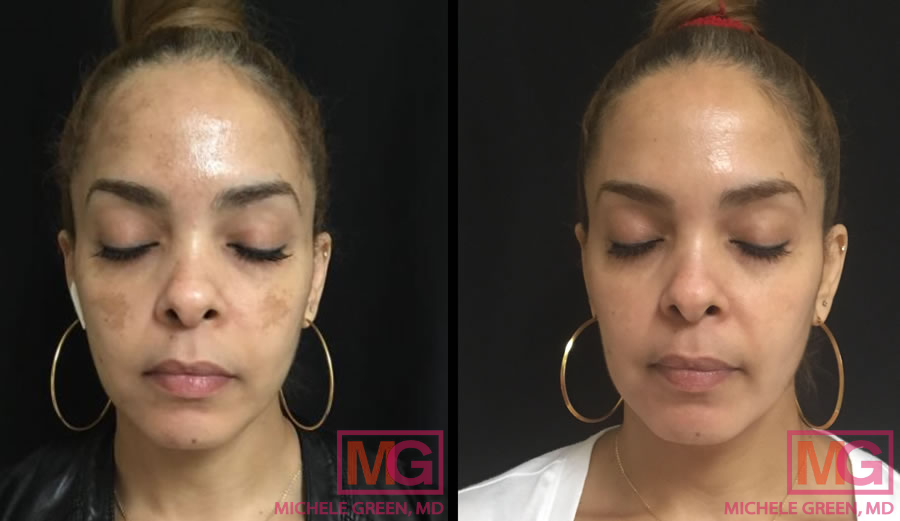
What is melasma?
Melasma is a common skin condition characterized by light brown, dark brown, or gray-brown patches that are darker than the surrounding skin tone. This type of hyperpigmentation typically occurs on the face, particularly on the upper lip, forehead, bridge of the nose, and cheeks, and is often symmetrical on both sides of the face. Melasma can also appear on the body, frequently in areas with regular sun exposure, such as the forearms, neck, and shoulders. While it is difficult to predict when melasma will first develop, it tends to be more common during reproductive years and is rare before puberty. This condition affects women more than men, particularly those between the ages of 20 and 40, due to the hormonal changes that occur naturally. Melasma is also more prevalent in medium to darker skin tones, including individuals of Asian, Hispanic, and African heritage, because of the naturally higher number of melanocytes in the skin.
Melasma is not harmful and is not associated with other symptoms like itchiness, burning, or pain. However, the appearance of discoloration and skin pigmentation can be disheartening for many people. Furthermore, melasma can be challenging to differentiate from other types of hyperpigmentation, making it crucial to accurately diagnose melasma in order to receive the best treatment. It is advisable to seek guidance from a board-certified dermatologist, such as Dr. Green, for the safest and most effective melasma treatment options.
What causes melasma?
Melasma occurs due to excessive melanin production by melanocytes in the epidermal or dermal layers of the skin. Although the exact cause of the overactive melanocytes is not known, various risk factors can exacerbate melasma:
Sun exposure – Sun exposure is the most common trigger for melasma. UV rays from the sun prompt melanocytes to produce melanin as a defense mechanism for the skin, potentially worsening or triggering melasma. UV radiation from tanning beds can also aggravate the appearance of melasma. It is essential for anyone dealing with melasma to apply broad-spectrum sunscreen with at least SPF 50 daily and to avoid all forms of UV radiation. Sun exposure can even lead to a recurrence of melasma that has been previously treated with dermatologic therapies.
Hormonal changes – Birth control pills, oral contraceptives, pregnancy, and hormone replacement therapy are commonly noted to trigger melasma. In fact, melasma is often referred to as chloasma or the “mask of pregnancy” for this reason. The onset of melasma due to hormonal changes can be linked to increased levels of the female sex hormones estrogen and progesterone. As estrogen and progesterone levels rise, melanocytes multiply and become more sensitive to the sun’s UV rays. Pregnant women or patients taking hormonal medications often find that their melasma fades after they give birth or once they stop the medications.
Genetics – Genetics may play a role in the development of melasma, as individuals with a family history of the condition are more likely to experience it. Furthermore, identical twins frequently exhibit similar symptoms of melasma, providing further evidence that genetics significantly influences its development.
Thyroid disease – Melasma and thyroid disorders may be connected, as the incidence of thyroid disease is four times greater in patients with melasma compared to the general population. Research has indicated elevated serum TSH, anti-thyroid peroxidase, and anti-thyroglobulin antibodies in patients experiencing melasma. However, more comprehensive clinical studies are required to establish a definitive link between thyroid disorders and melasma.
Medications – Certain oral antibiotics, cardiac medications, and other photosensitizing drugs can induce or worsen melasma. These medications include nonsteroidal anti-inflammatory drugs, antipsychotics, and antiseizure medications.
What is the difference between melasma and hyperpigmentation?
Melasma is a specific type of hyperpigmentation that appears as dark brown or gray patches on the skin. It typically manifests symmetrically, meaning the pigmented patches on both sides of the face follow a similar pattern. While the exact cause of melasma remains unknown, certain risk factors are known to worsen the condition, including sun exposure, tanning beds, hormonal changes (such as pregnancy and the use of oral contraceptives), certain medications, skin tone, genetics, and thyroid disease. Melasma is more prevalent in women than in men and is more common among individuals with darker skin tones, such as those of Hispanic, African, and Asian descent, due to the naturally high concentration of melanocytes in their skin. This condition is chronic and does not resolve on its own without in-office treatments and targeted skincare products. There is no cure for melasma, and discoloration can recur on the skin even after treatment if patients do not follow proper sun protection.
Hyperpigmentation refers to any skin condition that results in discoloration darker than the surrounding skin tone. In addition to melasma, other forms of hyperpigmentation include sun spots, freckles, and post-inflammatory hyperpigmentation (PIH). Sun spots and freckles occur due to an overproduction of melanin and excessive sun exposure. These spots appear as small pigmented areas that are darker than the surrounding skin. Unlike melasma, age spots may present as clusters or individual spots and are typically asymmetrical. Age spots are more prevalent in individuals with fair skin, while melasma primarily affects those with darker skin tones. Sun spots and freckles can be effectively treated with various non-invasive cosmetic procedures. PIH is a specific type of hyperpigmentation that develops after an inflammatory skin condition, such as acne lesions, injuries, eczema, dermatitis, or psoriasis, or as a result of improper laser treatment. PIH can gradually resolve on its own or be managed with in-office procedures and topical skincare products.
A significant difference between melasma and other forms of hyperpigmentation is the types of treatments that can be employed. Lasers such as Fraxel, AlexTrivantage, and Intense Pulsed Light (IPL), which are commonly used to address sun spots and age spots, should be avoided for melasma treatment. When lasers are applied to melasma, the heat can cause the pigment to become more deeply embedded in the skin, worsening its appearance and complicating treatment. Cosmelan peels, Mesopeels, microneedling, and targeted skincare ingredients are more effective for treating melasma. Dr. Green has over 25 years of experience in treating melasma, sun spots, and other forms of hyperpigmentation across all skin types. With her expertise, Dr. Green can accurately identify the discoloration as melasma, sun spots, or other types of hyperpigmentation through a simple physical assessment. She is also skilled in addressing post-inflammatory hyperpigmentation from various causes, including acne breakouts, unwanted side effects of laser treatments, or other inflammatory skin conditions such as eczema or psoriasis.
Do I have melasma or hyperpigmentation?
The best way to understand your skin condition is to schedule a consultation with an experienced, board-certified dermatologist, such as Dr. Michele Green, in New York City. There are various types of hyperpigmentation, and pinpointing which type or combination you have can be challenging without the help of a trained dermatologist or other medical expert. Dr. Green is an internationally recognized authority in cosmetic dermatology, boasting over twenty-five years of experience providing some of the world’s most discerning individuals with the finest non-invasive treatment options, including those for hyperpigmentation and melasma. During your consultation with Dr. Green regarding facial rejuvenation, she will gather a comprehensive medical and family history, conduct a physical assessment of your skin, and review any previous cosmetic procedures or treatments you have pursued. She will then collaborate with you to create a personalized treatment plan that addresses your specific skin concerns and delivers natural-looking, long-lasting results, ensuring that you look and feel like the best version of yourself.
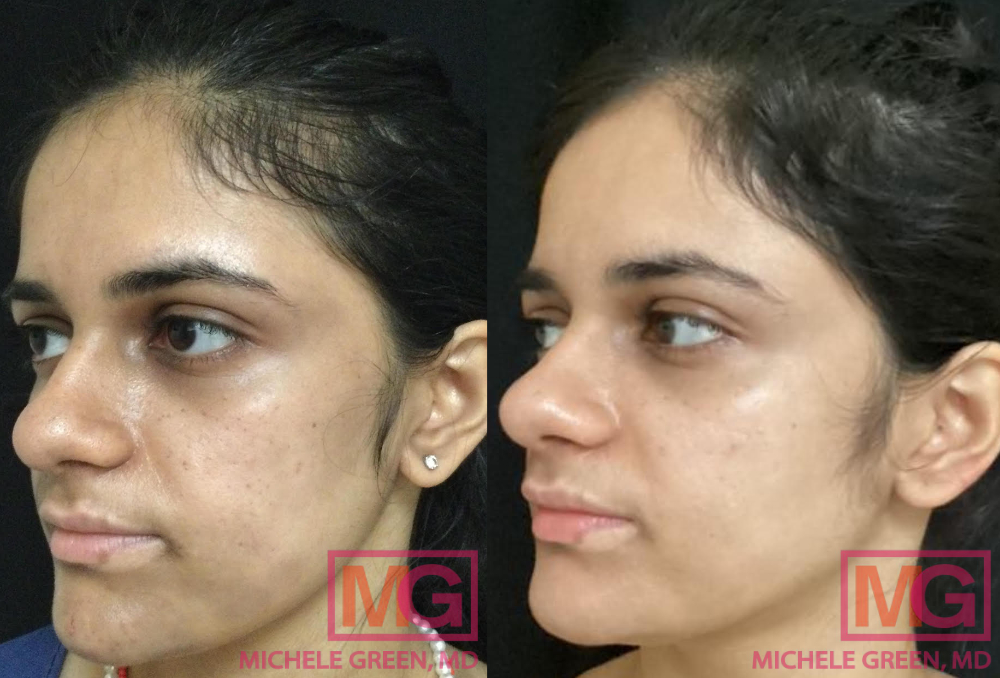
Dermatologist-approved treatment options for melasma and hyperpigmentation
Cosmelan Peel to treat melasma and hyperpigmentation
The Cosmelan peel is a medical-grade chemical peel designed to treat melasma and other forms of hyperpigmentation. Cosmelan accelerates epidermal renewal to eliminate melanin buildup, inhibit pigment migration to the epidermal layers of skin, and reduce melanin synthesis within melanocytes. The initial step of the Cosmelan peel involves Dr. Green professionally applying the Cosmelan 1 mask, which is then left on for a duration determined by Dr. Green, tailored to skin tone and the severity of the discoloration. After the specified time has passed, the patient should remove the Cosmelan 1 mask at home using a gentle cleanser. Patients are advised to use the Cosmelan home kit, which includes the Cosmelan 2 depigmentation cream, a gentle hydrating moisturizer, and a broad-spectrum sunscreen to enhance and maintain the treatment results. Following four weeks of using the Cosmelan home kit, a follow-up appointment with Dr. Green will be scheduled to assess progress and make any necessary adjustments to the protocol for optimal maintenance of healthy-looking skin and prevention of hyperpigmentation recurrence. Cosmelan offers an incredibly effective treatment option that provides a long-lasting, even-toned, radiant complexion with minimal downtime.
Mesopeels for skin lightening
Mesopeels are specially formulated chemical peels developed by Mesoestetic, the same company that created the Cosmelan peel. Mesopeels gently yet effectively target skin discoloration, dark spots, and photoaging. The formulation includes active skin-lightening ingredients that regulate melanocyte activity. Additionally, mesopeels utilize chemo-exfoliation to accelerate skin cell turnover, bringing healthy, vibrant skin cells to the surface. Mesopeels can be applied to both the face and body, even in sensitive areas such as around the eyes, inner thighs, groin, and axillae. Mesopeels are safe for patients of all skin types and tones, including those with darker skin tones. Patients are advised to undergo a series of mesopeels to achieve optimal cosmetic results. The exact number of mesopeels needed for treatment may vary depending on the treatment area and the severity of the initial hyperpigmentation.
TCA peels to treat hyperpimgentation
A trichloroacetic acid (TCA) peel is a type of chemical peel available in various strengths to treat a range of skin conditions, including hyperpigmentation, acne breakouts, fine lines and wrinkles, dullness, and sun damage. A TCA peel removes the surface layers of the epidermis, promoting increased skin cell renewal to reveal a healthier, brighter, and smoother complexion that is more even in tone. These chemical peels also enhance collagen production, smoothing the skin and reducing the appearance of fine lines and uneven skin texture. Multiple treatment sessions are ideal for achieving the best aesthetic results. TCA peels are generally not recommended for patients with darker skin tones, as adverse side effects may occur.
Microneedling with depigmenting solution
Microneedling, also known as collagen induction therapy, is a non-invasive treatment option for overall skin rejuvenation. Dr. Green uses a handheld device with tiny, insulated needles to create micro-injuries in the epidermal layers of skin. These micro-injuries stimulate collagen production and accelerate skin cell turnover, enhancing the appearance of discoloration, fine lines, wrinkles, acne scars, stretch marks, enlarged pores, and uneven skin tone and texture. Additionally, the microchannels created during the microneedling treatment improve the absorption of specialized serums. For patients primarily focused on treating melasma and hyperpigmentation, combining microneedling with a depigmenting serum produces exceptional skin-lightening results. The depigmenting serum used in the private dermatology office is a unique blend of powerful yet gentle skin-brightening agents that combat melanocyte activity in the skin. The result is an even-toned complexion with a noticeable reduction in hyperpigmentation. Patients appreciate that after their microneedling treatment with a depigmenting serum, their skin appears more radiant and maintains a lasting healthy glow.
HydraFacials to reduce facial pigmentation and discoloration
A HydraFacial is a three-step procedure designed to cleanse, exfoliate, and nourish the skin, leading to a clearer, brighter complexion. Its patented vortex technology allows active ingredients to penetrate deeply into the pores, maximizing the treatment’s effectiveness. The first step thoroughly cleanses the pores. The second step provides gentle exfoliation to eliminate dead skin cells, excess oil, dirt, and other impurities from the pores. The third and final step delivers essential vitamins, nutrients, and peptides to replenish and hydrate the skin. The HydraFacial treatment can be enhanced with boosters targeting specific skin concerns, such as melasma, hyperpigmentation, acne, dullness, and aging. The Murad Vita-C skin booster contains vitamin C, tranexamic acid, glycolic acid, and Murad’s proprietary molecule RepleniCell to brighten and hydrate the skin. The Britenol skin booster features vitamin C and alpha-arbutin to diminish hyperpigmentation and protect the skin from oxidative stress and free radical damage.
VBeam laser for post-inflammatory hyperpigmentation and melasma
The VBeam laser is a pulsed dye treatment designed to treat facial redness, broken capillaries, and spider veins. It is also highly effective in reducing redness and inflammation associated with post-inflammatory hyperpigmentation and melasma. The VBeam works by emitting bursts of light at a wavelength of 595 nanometers, specifically targeting variations in the red pigment of the skin. The energy generated is transformed into heat and absorbed by the pigment-producing cells. Consequently, the VBeam laser does not affect other areas of the skin while effectively addressing the underlying redness. This treatment is safe and effective for patients of all skin types and tones, with no downtime associated with it. Typically, 4 to 6 laser sessions spaced one month apart can significantly reduce inflammation caused by melasma and other hyperpigmentation disorders.
Laser treatments for hyperpigmentation that are not suited for melasma
Fraxel laser for sun damage and hyperpigmentation
Fraxel is a resurfacing laser treatment that Dr. Green often refers to as the “magic eraser” for its unique ability to target various skin concerns. The Fraxel laser used by Dr. Green features two wavelengths: 1927, which is optimal for addressing hyperpigmentation and sun spots, and 1550, which treats wrinkles, stretch marks, and acne scars. The Fraxel laser creates controlled, microscopic wounds in the skin by applying highly concentrated laser pulses. As the skin heals these wounds, it produces new collagen, encourages the growth of new skin cells, and starts to repair sun damage, revealing a brighter, more radiant complexion. When used on the 1927nm setting, Fraxel effectively reduces the appearance of dark sunspots on the face, neck, chest, arms, or legs. There is minimal downtime, with patients experiencing mild redness and swelling in the treatment area for 48 hours. Those treating sun spots and sun damage may also notice peeling similar to a ‘rough sandpaper’ texture on the skin for an additional three to five days. A series of treatments spaced one month apart is necessary to diminish sun spots and achieve a fully even-toned complexion.
AlexTrivantage for sun spots and age spots
Candela’s AlexTrivantage is a well-known laser in Dr. Green’s NYC office, valued for its ability to target and eliminate distinct sun spots or age spots on the skin. During treatment, a specific wavelength of light is delivered to the skin and absorbed by the melanin in these dark spots. The light energy is then converted into heat, breaking down and destroying the pigmentation while leaving the surrounding tissue unharmed. The AlexTrivantage laser is also effective for addressing unwanted birthmarks and pigmented tattoos. Treatments involve minimal downtime, allowing patients to remove their sun spots in as few as one or two sessions.
Clear + Brilliant laser for discoloration
The Clear + Brilliant laser, often referred to as the “mini-Fraxel,” is a resurfacing laser treatment frequently used to minimize dark spots and sun damage. This treatment employs fractionated laser technology, which creates millions of tiny microscopic treatment zones that stimulate new collagen formation and replace damaged skin. The Permea handpiece is specifically designed to eliminate facial pigmentation in 4 to 6 sessions. In addition to addressing hyperpigmentation, the Clear + Brilliant laser also targets visible signs of aging, including fine lines, wrinkles, enlarged pores, and mild acne scars, resulting in a more even skin tone and texture.
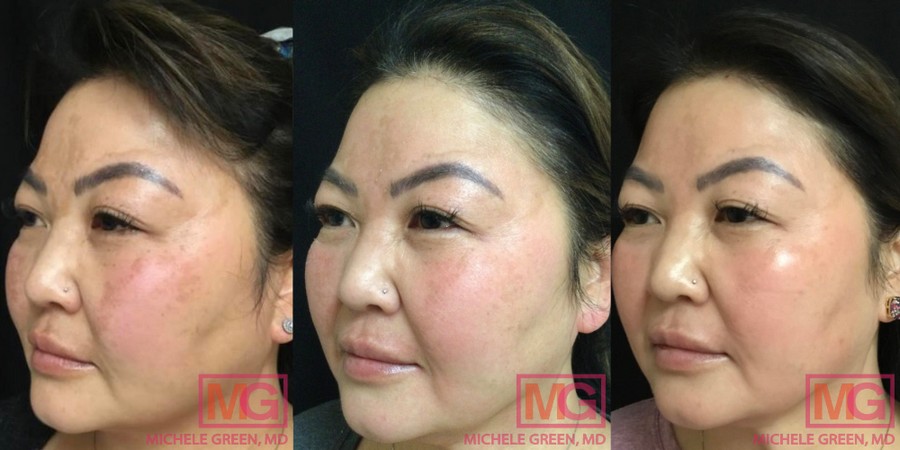
What are the best treatment products to use for facial melasma and hyperpigmentation?
A proper skincare regimen is essential for any patient with melasma and hyperpigmentation to maintain and enhance the benefits of cosmetic treatment. Dr. Green developed a proprietary skincare line, MGSKINLABs, specifically to address various skin concerns, including melasma and hyperpigmentation. When you consult with Dr. Green, she will customize a unique skincare regimen with the best topical treatments to gradually reduce your hyperpigmentation and help you achieve clear, radiant skin.
Sunscreen is essential in any skincare routine, particularly for patients with hyperpigmentation and melasma. The sun’s UV rays stimulate melanocytes to produce melanin, which can trigger or worsen melasma and lead to the development of sun spots or age spots on the skin. It is crucial to apply a broad-spectrum sunscreen with an SPF of 50 or higher to protect against UVA and UVB rays. Sunscreen should be used daily and reapplied every 90 minutes, or after engaging in any water activities. Additionally, Dr. Green recommends that patients with melasma use both chemical and physical sunscreens for maximum protection. Chemical sunscreens contain ingredients like oxybenzone or avobenzone, which convert harmful UV rays into harmless heat energy. Physical sunscreens contain ingredients like zinc oxide or titanium dioxide to form a protective barrier on the skin. Some sunscreens may also contain iron oxide to block visible light, providing enhanced protection. The Hydrating SPF 50 from MGSKINLABs is an excellent physical sunscreen that contains zinc oxide for UV protection, along with hyaluronic acid and lactic acid to hydrate and soften the skin.
Hydroquinone is a skin-lightening ingredient that helps inhibit melanin production to reduce areas of hyperpigmentation and melasma. Hydroquinone creams are available only by prescription from a board-certified dermatologist like Dr. Green. The strengths of hydroquinones range from 4% to 10%, depending on your skin type and the severity of hyperpigmentation. Hydroquinone is not intended for long-term use, and patients should consistently follow up with Dr. Green when prescribed hydroquinone so she can adjust their skincare regimen for hyperpigmentation as needed. Additionally, it is essential to practice proper sun protection when using hydroquinone since it increases the skin’s sensitivity to sunlight.
Retinol and retinoids are topical derivatives of vitamin A that enhance the rate of skin cell turnover, removing discolored, dead skin cells and promoting young, healthy skin cells to reach the skin’s surface more quickly than they would on their own. The MGSKINLAB skincare line features a gentle yet effective retinol, the Essential Antioxidant Infusion, designed to accelerate skin cell renewal and create a more even skin tone. Patients with moderate to severe hyperpigmentation can obtain a retinoid like tretinoin or Retin-A through a prescription from a board-certified dermatologist. Some retinoids are also blended with other active ingredients, such as steroids, for optimal effectiveness. The Kligman Formula is a classic treatment that combines tretinoin with a low-dose corticosteroid cream to reduce post-inflammatory hyperpigmentation. Sunscreen must be applied when using a retinol or retinoid, as these vitamin A derivatives heighten skin photosensitivity.
Vitamin C is a potent antioxidant skincare ingredient that enhances skin tone and texture. It also boosts protection against harmful free radicals and oxidative stress. Dr. Green’s MGSKINLAB’s Vita-C Serum is formulated with a high potency of vitamin C to promote skin cell renewal and collagen synthesis, leading to a reduction in the appearance of dark spots and an improved overall complexion.
Other excellent skin-lightening ingredients include tranexamic acid, azelaic acid, kojic acid, and glycolic acid. Tranexamic acid and azelaic acid are both tyrosinase inhibitors that interfere with melanin production. Kojic acid is a naturally derived topical treatment for hyperpigmentation that inhibits excessive melanin production. Glycolic acid promotes a faster rate of skin cell renewal, exfoliating discolored, dead skin cells and encouraging the generation of healthy, new skin cells that blend more evenly with the surrounding skin tone. The Skin Brightening Cream from MGSKINLABs features a unique blend of kojic acid, glycolic acid, lactic acid, and fruit extracts to rejuvenate pigmented skin.
FAQs about hyperpigmentation vs melasma
Is hyperpigmentation the same as melasma?
Yes and no. All melasma is hyperpigmentation, but not all hyperpigmentation is melasma. Hyperpigmentation is a general term that describes any form of skin discoloration that is darker than the natural skin tone. There are various forms of hyperpigmentation, including sun spots, age spots, melasma, and post-inflammatory hyperpigmentation. Hyperpigmentation is caused by an increase in melanin in the skin and most commonly develops due to excessive sun exposure. Melasma is a skin condition and a more specific type of hyperpigmentation characterized by dark patches of skin that are brown or brownish-gray in color. Melasma is triggered and worsened by various factors that differ from those affecting other types of hyperpigmentation, including hormonal changes, certain medications, and genetics.
It can be challenging to distinguish between hyperpigmentation and melasma, as they often appear similar to those who are unfamiliar with these conditions. However, differentiating between the two is vital because various treatments, such as laser therapies, for hyperpigmentation may actually worsen melasma. Furthermore, treating hyperpigmentation and melasma in patients with darker skin tones requires caution, as improper management of any discoloration can worsen pigmentation issues. Board-certified dermatologist Dr. Michele Green has successfully treated hyperpigmentation and melasma for over two decades in her private dermatology practice in New York City, working with all skin types and tones. During your consultation with Dr. Green, she will assess your discoloration, identify the specific type of hyperpigmentation, and formulate a treatment plan designed to help you achieve a brighter, more youthful complexion and restore your confidence.
Is hyperpigmentation the same as skin cancer?
No, hyperpigmentation is not the same as skin cancer. Hyperpigmentation refers to benign, flat, dark spots or patches of skin that are darker than the surrounding area. It develops due to an overproduction of melanin triggered by excessive exposure to UV radiation. In contrast, skin cancer involves the abnormal growth or proliferation of skin cells in a specific region. Most skin cancers arise from sun exposure, although genetics also plays a significant role in their development.
Hyperpigmentation and skin cancer look very different on the skin. Skin cancers are assessed based on the lesion’s asymmetry, irregular borders, color, size, and growth. If the lesion remains clinically concerning after evaluation, Dr. Green will perform a small biopsy of the area and send it to a laboratory for further testing. If you notice any new dark or unusual lesions and are unsure whether they are hyperpigmentation or skin cancer, it is crucial to consult a board-certified dermatologist, such as Dr. Green, for a prompt and accurate diagnosis.
What is the best treatment for melasma and hyperpigmentation on the face?
No single treatment is inherently the ‘best’ for melasma and hyperpigmentation; each patient’s treatment plan depends on various factors, including skin type, tone, and the nature and severity of skin concerns. Melasma is most effectively treated with chemical peels, such as the Cosmelan peel, which consistently delivers impressive results with minimal risk of side effects. Hyperpigmentation, particularly in the form of sunspots, can be effectively addressed with lasers like Fraxel, AlexTrivantage, and Clear + Brilliant. However, patients with darker skin tones are generally better suited for treatment with chemical peels, as these lasers can misinterpret dark skin tones as pigmented areas, potentially leading to burns. These patients can opt for chemical peels, such as the Cosmelan peel or Mesopeel, in combination with microneedling or HydraFacials for effective treatment. Regardless of skin tone or type, Dr. Green will help you develop a treatment plan tailored to your specific skin concerns and needs.
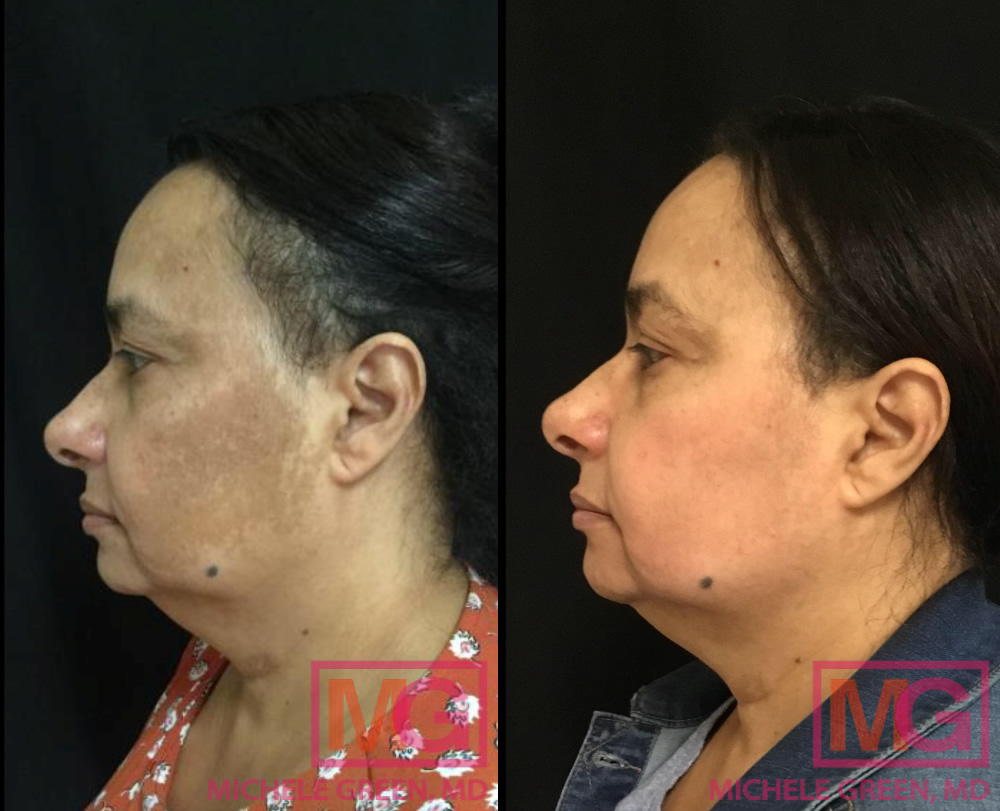
Which laser is best for melasma?
It is important to note that melasma is a type of hyperpigmentation that should not be treated with laser procedures. Laser treatment can make melasma even more difficult to eliminate, as it may deepen the hyperpigmentation in the skin’s underlying layers. Dr. Michele Green specializes in treating patients whose melasma and hyperpigmentation have worsened due to both ablative and non-ablative laser treatments. Dr. Green prefers to manage melasma using Cosmelan peels, Mesopeels, and VBeam laser treatment to prevent any further deterioration of the existing hyperpigmentation.
Which acid is best for melasma and hyperpigmentation?
An acid is a general term for any molecule that forms hydrogen ions when dissolved in water. In the realm of melasma and hyperpigmentation, key “acids” include trichloroacetic acid, tranexamic acid, azelaic acid, kojic acid, and glycolic acid. Trichloroacetic acid, or TCA, is utilized in chemical peels to provide gentle exfoliation, sloughing off dead, pigmented skin cells to reveal healthy, bright cells on the skin’s surface. Tranexamic acid, azelaic acid, and kojic acid are all topical skin-lightening ingredients that inhibit tyrosinase, an enzyme essential for melanin production, thus reducing melasma and hyperpigmentation. Glycolic acid is an alpha-hydroxy acid that gently exfoliates the skin to accelerate skin cell turnover and achieve a brighter complexion. No single acid is superior for melasma and hyperpigmentation; patients’ treatment plans often involve a combination of chemical peels and skincare products that employ a diverse array of acids to minimize hyperpigmentation and promote clear, radiant skin.
Can melasma be reversed?
If melasma is triggered by factors such as hormonal changes during pregnancy or birth control pills, it may fade on its own after childbirth or after discontinuing the medication. However, for many individuals, melasma is a chronic skin condition that can persist for many years or even a lifetime. The presence of facial discoloration can be frustrating, and over-the-counter skincare products and natural remedies might not provide the improvement you desire. Dr. Green has offered safe and effective melasma treatments in her New York City office for over 25 years. She will recommend appropriate melasma treatments tailored to your skin type and tone, and adjust your skincare products to reduce pigmentation and prevent the recurrence of melasma.
Does melasma come back after hydroquinone?
Yes, melasma and other forms of hyperpigmentation can recur after using hydroquinone. Hydroquinone is a skin-lightening agent that decreases the number of melanocytes and inhibits melanin production from these cells. It can be used to treat melasma and various types of hyperpigmentation, including acne scars, freckles, dark spots, sun spots, and age spots. However, hydroquinone is not meant for long-term use; strict sun protection is essential for maintaining the desired effect. Melasma and dark spots may return after stopping hydroquinone, particularly with ongoing sun exposure. Dr. Green always stresses the importance of daily broad-spectrum sunscreen to shield the skin from UVA and UVB rays, as well as wearing sun-protective clothing, such as a wide-brimmed hat. Additionally, Dr. Green advises discontinuing hydroquinone during the summer or if you plan a sunny vacation, as this ingredient can heighten the skin’s sensitivity to the sun.
What is the best way to prevent melasma and hyperpigmentation?
Avoiding the sun, using broad-spectrum SPF, and wearing sun-protective clothing are essential first steps to prevent melasma from worsening, as UV rays stimulate melanocytes to produce more melanin. Tanning beds can also aggravate pigmentation, so they should be avoided. Sunscreens should have a minimum SPF of 50 and provide broad-spectrum protection against both UVA and UVB rays. Additionally, they should be reapplied every 90 minutes after swimming or sweating for effective protection. Besides sunscreen, wearing wide-brimmed hats and sun-protective clothing labeled with a UPF (Ultraviolet Protection Factor) rating is highly recommended. The sun is strongest between 10 AM and 4 PM, so it’s advisable to minimize direct sun exposure during these hours or take extra precautions with sunscreen and hats. Furthermore, women with melasma can lower their risk of recurrence by discontinuing hormonal birth control pills or switching to a contraceptive method that does not contain hormones. However, not every individual should stop their medication, and patients should consult their obstetrician-gynecologist (OBGYN) or prescribing provider for guidance.
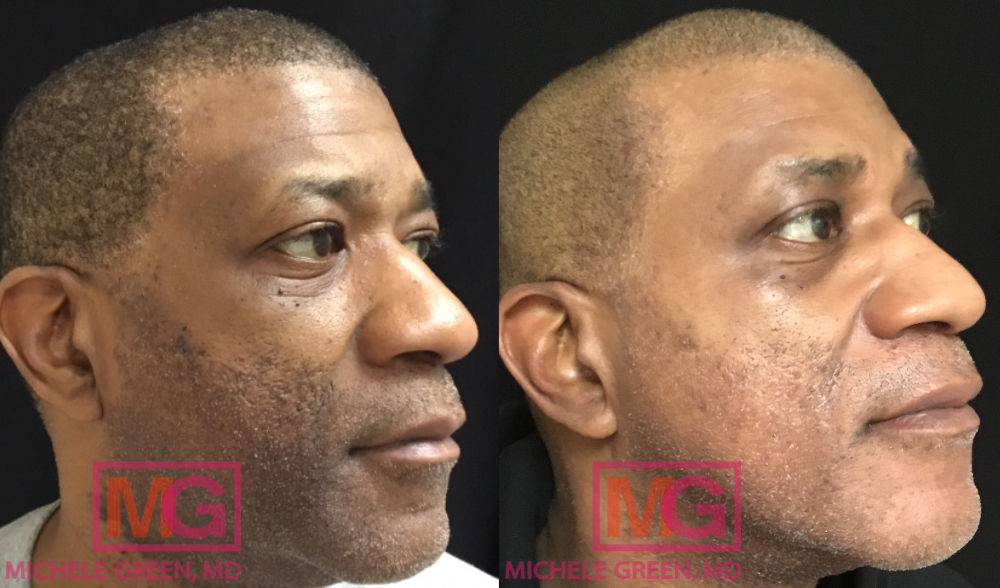
How do I get started with melasma and hyperpigmentation treatment today?
Hyperpigmentation is a broad term that refers to patches of skin that are darker than the surrounding areas. There are several types of hyperpigmentation, including sun spots, post-inflammatory hyperpigmentation, and freckles. Melasma is a specific form characterized by brown or gray patches on the skin. For many individuals, hyperpigmentation and melasma can lead to feelings of self-consciousness or low self-esteem. Fortunately, Dr. Green offers treatments such as Cosmelan peels, Mesopeels, Fraxel laser, AlexTrivantage laser, and microneedling to help you achieve a clear, radiant complexion, regardless of the type of hyperpigmentation you have. The most suitable treatment options for your hyperpigmentation will ultimately depend on your skin tone, skin type, and the severity and type of hyperpigmentation present. Consulting an experienced board-certified dermatologist like Dr. Green in New York City is the quickest and safest way to understand and address the hyperpigmentation affecting you, helping you return to looking and feeling like the best version of yourself.
Dr. Michele Green is an internationally renowned board-certified cosmetic dermatologist with over two and a half decades of experience providing some of the world’s most discerning men and women with the finest non-invasive treatment options, including those for hyperpigmentation and melasma. Castle Connolly, New York Magazine, Super Doctors, and The New York Times consistently recognize Dr. Green as one of NYC’s top dermatologists due to her dedication to her patients and her expertise. Dr. Green adopts a holistic approach and embraces a less-is-more philosophy regarding facial rejuvenation. She tailors her patients’ treatment plans to address their specific concerns and aesthetic goals, aiding them in achieving their desired cosmetic results. To begin treating your melasma or hyperpigmentation today, schedule a consultation with Dr. Green by contacting us online or calling the NYC-based office at 212-535-3088.
 212-535-3088
212-535-3088 